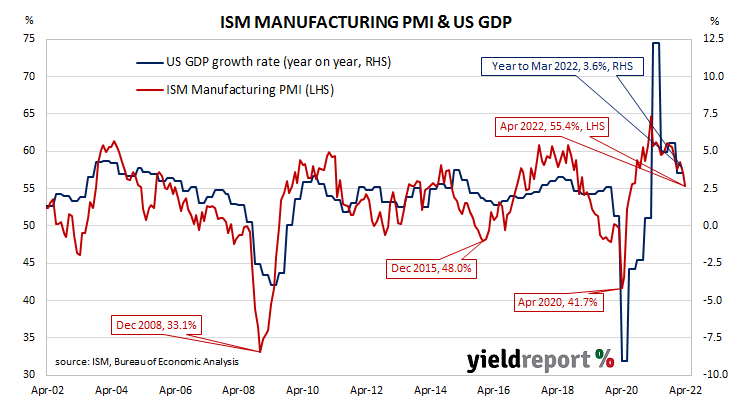Summary: ISM PMI down from 57.1% to 55.4% in April; below expectations; US manufacturing remains constrained, progress on labour shortages slowing; latest reading implies 3.7% 12-month US GDP growth rate in September.
The Institute of Supply Management (ISM) manufacturing Purchasing Managers Index (PMI) reached a cyclical peak in September 2017. It then started a downtrend which ended in March 2020 with a contraction in US manufacturing which lasted until June 2020. Subsequent month’s readings implied growth had resumed, with the index becoming stronger through to March 2021. Since then, readings have remained at elevated levels despite recent declines.
According to the ISM’s April survey, its PMI recorded a reading of 55.4%, below the generally expected figure of 57.7% as well as March’s 57.1%. The average reading since 1948 is 53.0% and any reading above 50% implies an expansion in the US manufacturing sector relative to the previous month.
Timothy Fiore, Chair of the ISM’s Manufacturing Business Survey Committee, said the US manufacturing sector remained constrained by supplier issues. Additionally, progress towards resolving labour shortages had slowed. “Panellists reported higher rates of quits compared to previous months, with fewer panellists reporting improvement in meeting head-count targets.”
Longer-term US Treasury yields increased moderately on the day. By the close of business, the 10-year Treasury bond yield had added 4bps to 2.98% and the 30-year yield had gained 3bps to 3.03%. The 2-year yield finished unchanged at 2.72%.
In terms of US Fed policy, expectations of higher federal funds rates over the next 12 months softened a little. At the close of business, May contracts implied an effective federal funds rate of 0.78%, 45bps higher than the current spot rate. August contracts implied a rate of 1.895% and March 2023 futures contracts implied 3.07%, nearly 275bps above the spot rate.
Purchasing managers’ indices (PMIs) are economic indicators derived from monthly surveys of executives in private-sector companies. They are diffusion indices, which means a reading of 50% represents no change from the previous period, while a reading under 50% implies respondents reported a deterioration on average.
A reading “above 48.7%, over a period of time, generally indicates an expansion of the overall economy”, according to the ISM.
The ISM’s manufacturing PMI figures appear to lead US GDP by several months despite a considerable error in any given month. The chart below shows US GDP on a “year on year” basis (and not the BEA annualised basis) against US GDP implied by monthly PMI figures.
According to the ISM and its analysis of past relationships between the PMI and US GDP, April’s PMI corresponds to an annualised growth rate of 2.3%, or 0.6% over a quarter. Regression analysis on a year-on-year basis suggests a 12-month GDP growth rate of 3.7% five months after this latest report.
The ISM index is one of two monthly US PMIs, the other being an index published by IHS Markit. IHS Markit also produces a “flash” estimate in the last week of each month which comes out about a week before the ISM index is published. The IHS Markit April flash manufacturing PMI registered 59.7%, 0.9 percentage points higher than March’s final figure.



